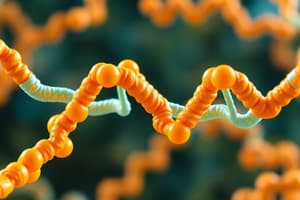Podcast
Questions and Answers
What is the term used to describe the state where the rate of protein synthesis equals the rate of breakdown and loss?
What is the term used to describe the state where the rate of protein synthesis equals the rate of breakdown and loss?
- Negative balance
- Nitrogen balance (correct)
- Anabolic state
- Positive balance
Which group of hormones accelerates protein synthesis?
Which group of hormones accelerates protein synthesis?
- Anabolic hormones like GH and sex hormones (correct)
- Thyroid hormones
- Insulin and glucagon
- Cortisol and adrenaline
What happens when the rate of protein breakdown exceeds the rate of synthesis in the body?
What happens when the rate of protein breakdown exceeds the rate of synthesis in the body?
- Negative nitrogen balance (correct)
- Anabolic state
- Positive nitrogen balance
- Excessive muscle growth
Which of the following amino acids is considered essential for infants?
Which of the following amino acids is considered essential for infants?
What is the main consequence of inadequate caloric intake with respect to protein use in the body?
What is the main consequence of inadequate caloric intake with respect to protein use in the body?
Which vitamins are synthesized in the body and are crucial for helping the body use nutrients effectively?
Which vitamins are synthesized in the body and are crucial for helping the body use nutrients effectively?
Which of the following is an essential function of proteins in the body?
Which of the following is an essential function of proteins in the body?
What is the main role of amino acids in the body?
What is the main role of amino acids in the body?
Which type of proteins lack some essential amino acids?
Which type of proteins lack some essential amino acids?
What are the essential fatty acids that must be ingested through diet?
What are the essential fatty acids that must be ingested through diet?
Which body cells primarily rely on glucose as their main fuel source to make ATP?
Which body cells primarily rely on glucose as their main fuel source to make ATP?
What is a major function of phospholipids in the body?
What is a major function of phospholipids in the body?
What are the main functions of proteins in the body?
What are the main functions of proteins in the body?
Which of the following is NOT a product of the oxidative breakdown of nutrients in the mitochondria?
Which of the following is NOT a product of the oxidative breakdown of nutrients in the mitochondria?
Why are essential amino acids important in the body?
Why are essential amino acids important in the body?
Which of the following is a key factor in protein synthesis within tissue cells?
Which of the following is a key factor in protein synthesis within tissue cells?
What role do coenzymes like NAD+ and FAD play in cellular metabolism?
What role do coenzymes like NAD+ and FAD play in cellular metabolism?
Which process involves the incorporation of proteins into molecules and the breakdown of nutrients to form intermediates within tissue cells?
Which process involves the incorporation of proteins into molecules and the breakdown of nutrients to form intermediates within tissue cells?
Study Notes
Protein Synthesis
- All amino acids must be present for protein synthesis to occur
- Insufficient carbohydrate or fat availability leads to protein being used as fuel
Nitrogen Balance
- State where protein synthesis rate equals protein breakdown and loss rate
- Positive nitrogen balance: synthesis exceeds breakdown (normal in children and tissue repair)
- Negative nitrogen balance: breakdown exceeds synthesis (e.g., stress, burns, infection, or injury)
Hormonal Controls
- Anabolic hormones (GH, sex hormones) accelerate protein synthesis
Essential Amino Acids
- Threonine, Leucine, Phenylalanine, Isoleucine, Lysine, Histidine (infants), Arginine (infants) are essential amino acids
- Valine and Methionine are also essential amino acids
- Tryptophan and Methionine are important amino acids
Vitamins
- Organic compounds crucial in helping the body use nutrients
- Most function as coenzymes
- Vitamins D, some B, and K are synthesized in the body
- Two types: water-soluble and fat-soluble
- Water-soluble vitamins: B complex and C, absorbed with water, not stored in the body
- Fat-soluble vitamins: Vitamins A, D, E, and K, require fat for absorption
Nutrients
- Major nutrients: Carbohydrates, Lipids, and Proteins
- Other nutrients: Vitamins, Minerals, and Water
- Energy (ATP) is derived from Carbohydrates, Lipids, and Proteins
Carbohydrates
- Dietary sources: Starch, Sugars, Insoluble fiber, Soluble fiber
- Uses: Glucose is the fuel used by cells to make ATP, neurons and RBCs rely on glucose
- Excess glucose is converted to glycogen or fat and stored
Lipids
- Dietary sources: Triglycerides, Saturated fats, Unsaturated fats, Cholesterol
- Essential fatty acids: Linoleic and linolenic acid, found in most vegetable oils
- Uses: Help absorb fat-soluble vitamins, major fuel of hepatocytes and skeletal muscle, phospholipids are essential in myelin sheaths and all cell membranes
- Functions of fatty deposits: Protective cushions, Insulating layer, Concentrated source of energy
- Regulatory functions of prostaglandins: Smooth muscle contraction, Control of blood pressure, Inflammation
- Functions of cholesterol: Stabilizes membranes, Precursor of bile salts and steroid hormones
Cellular Metabolic Processes
- Stage 1: Digestion, absorption, and transport to tissues
- Stage 2: Cellular processing, synthesis of lipids, proteins, and glycogen, or catabolism into intermediates
- Stage 3: Oxidative breakdown of intermediates into CO2, water, and ATP
Oxidation-Reduction (Redox) Reactions
- Oxidation: gain of oxygen or loss of hydrogen
- Reduced substances gain electrons and energy
- Coenzymes act as hydrogen (or electron) acceptors: NAD+, FAD
ATP Synthesis
- Two mechanisms: Substrate-level phosphorylation, Oxidative phosphorylation
Studying That Suits You
Use AI to generate personalized quizzes and flashcards to suit your learning preferences.
Description
Test your knowledge on protein synthesis, the all-or-none rule, adequacy of caloric intake, nitrogen balance, and hormonal controls. Understand how various factors can impact protein synthesis and breakdown.




